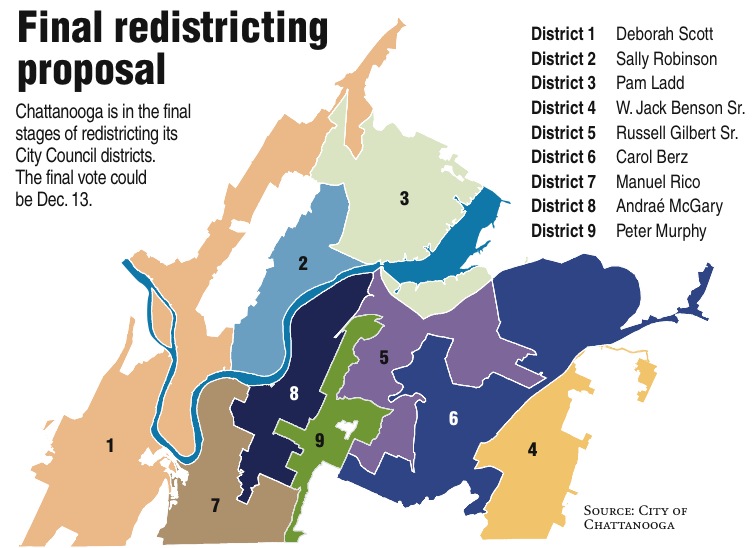Two redistricting plans have created controversy over what Chattanooga should look like over the next 10 years.
One plan was made and has been approved by the City Council. The other was proposed by black community leaders and given to the council to ponder.
The council plan takes into account an increasing Hispanic population. The community plan tries to keep a strong black majority in four districts.
The community plan shifts some of the traditional black-majority districts east, creating major changes in districts 6 and 8.
"What it said to me was that it was drawn by someone who isn't from Chattanooga and doesn't understand Chattanooga," said Councilman Peter Murphy, chairman of the council's Legal and Legislative Committee, who represents District 9.
But state Rep. Tommie Brown, D-Chattanooga, who enlisted a demographer and an attorney to come up with the plan, said that was nonsense.
"We didn't wake up yesterday and start looking at this," she said. "We're not some 'Johnny come lately' group."
Political lines are redrawn every 10 years after the national census to take into account shifting populations and changing borders. In its redistricting process, Chattanooga also must take care not to retrogress under the Voting Rights Act of 1965.
Last week, council members approved their own plan on first reading in a 6-0 vote. The second reading will be Tuesday night.
The city attorney's office has said the council's redistricting plan should be able to withstand any challenges.
Joe Rowe, first vice president for the local NAACP chapter, said the council's plan does only one thing.
"It's pretty obvious they are protecting their turf," he said.
He said the council-drawn districts don't take into account annexation and some places where gentrification will occur.
"It looks like we will only have one black face on the City Council in 10 years," Rowe said. Today, two of the city's nine council members are black and one is Hispanic. Four council members are women.
But Murphy said that things just didn't seem to come together in the community plan. He said he lost 30 percent of his district, and District 8, which is represented by Andraé McGary, would only keep 20 percent of its current boundaries.
COMPARING PLANSA group of black leaders handed the Chattanooga City Council a proposal last week to create four majority-black districts. The City Council also has its own proposal. Here's how the community plan differs from the council proposal.• Districts 1, 2 and 3 are the same in both plans.• District 4: Large portions of Concord would go to District 6.• District 5: Airport and Eastgate Town Center areas shift into District 5.• District 6: Loses airport and Eastgate areas and shifts east toward East Brainerd• District 7: Gathers huge swaths of downtown, including most of Highland Park and Eastside.• District 8: Shifts a little eastward, taking in parts of District 5.• District 9: Shifts south, taking in East Lake and Cedar Hill, and taps parts of Districts 5 and 6 to the east.
"It looked like they were changing things just to disrupt things," he said.
Councilman Manny Rico, who would see large portions of his district change under the community plan, agreed.
He said the community plan would take East Lake and Cedar Hills away from him.
"These are people I've represented for six years," he said.
In turn, the plan would have given him Highland Park and Eastside.
But Brown, who was the lead plaintiff in a lawsuit that led to the switch from a city commission to a council-mayor government, said the professionals that worked on the plan for her came up with the best scenario.
She scoffed at any mention that the plan came from outside Chattanooga.
"Who do you think filed the lawsuit?" she asked. "Who do you think has been watching the last 25 years? I probably know them better than they know themselves."

